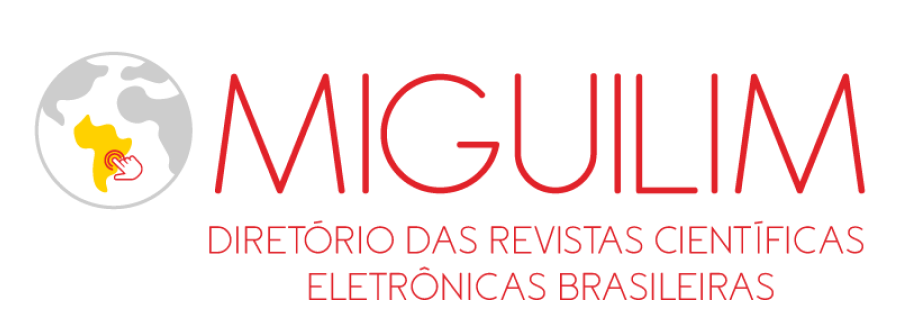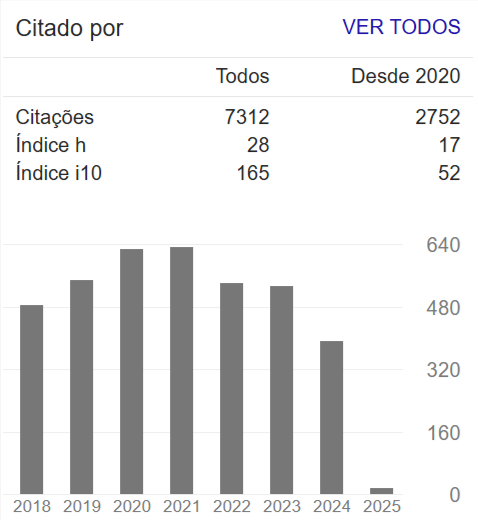Remoção de oxitetraciclina veterinária pelo sistema H2O2/UV
Resumen
O uso de antibióticos em posologia terapêutica e como aditivos alimentares garantem a alta produtividade da pecuária. A oxitetraciclina (OTC) veterinária é um dos antibióticos mais utilizados e com importante inserção no meio ambiente. A OTC é um contaminante persistente aos tratamentos convencionais de água. O presente estudo simulou uma solução de OTC veterinária utilizada como aditivo alimentar na criação de aves. No uso real, essas soluções são disponibilizadas aos animais para sua dessedentação e são descartadas após 24 horas. Assim, o presente estudo objetiva avaliar a capacidade de remoção da OTC de formulação veterinária pelo sistema H2O2/UV a partir de testes com diferentes valores de pH e de concentrações do H2O2. Fez-se uso de um planejamento fatorial do tipo delineamento composto central rotacional (DCCR) e as principais configurações foram o tempo de operação de 60 minutos, três lâmpadas UV-C (254 nm) de 15 W cada, concentração inicial da OTC de 15 mg L-1 e o volume de água deionizada de 250 mL (operando em regime de batelada). Obteve-se uma remoção máxima de 97% de OTC com pH 6,5 e concentração de 150 mg L-1 de H2O2, além de um modelo matemático com capacidade de explicação de 94,12% da variabilidade dos dados com um nível de significância de 5%. Concluindo-se que o sistema H2O2/UV possui capacidade real de degradação de uma solução de OTC veterinária.
Citas
AHMED, I.; KASRAIAN, K. Pharmaceutical challenges in veteri-nary product development. Advanced Drug Delivery Reviews, v.54, p.871-882, 2002. PII: S0169-409X(02)00074-1
ALMEIDA, A. R.; TACÃO, M.; MACHADO, A. L.; GOLOVKO, O.; ZLABEK, V.; DOMINGUES, I.; HENRIQUES, I. Long-term effects of oxytetracycline exposure in zebrafish: a multi-level perspec-tive. Chemosphere, v. 222, p. 333-344, 2019. https://doi.org/10.1016/j.chemosphere.2019.01.147
ASHFAQ, M.; LI, Y.; REHMAN, M. S. U.; ZUBAIR, M.; MUSTAFA, G.; NAZAR, M. F; YU, C. P.; SUN, Q. Occurrence, spatial variation and risk assessment of pharmaceuticals and personal care products in urban wastewater, canal surface water, and their sediments: A case study of Lahore, Pakistan. Science of the Total Environment, v.688, p.653-663, 2019. https://doi.org/10.1016/j.scitotenv.2019.06.285
BAXENDALE, J. H.; WILSON, J. A. The photolysis of hydrogen peroxide at high light intensities. Transactions of the Faraday Society, v.53, p.344-356, 1957. https://dx.doi.org/10.1039/tf9575300344
BEN, Y.; HU, M.; ZHANG, X.; WU, S.; WONG, M. H.; WANG, M.; ANDREWS, C. B.; ZHENG, C. Efficient detection and assess-ment of human exposure to trace antibiotic residues in drink-ing water. Water Research, v.175, p.1-11, 2020. https://doi.org/10.1016/j.watres.2020.115699
BORGHI, A. A.; PALMA, M. S. A. Tetracycline: production, waste treatment and environmental impact assessment. Brazilian Journal of Pharmaceutical Sciences. v.50, n.1, 2014. http://dx.doi.org/10.1590/S1984-82502011000100003
CARDINAL, K. M.; KIPPER, M.; RIBEIRO, A. M. L. Withdrawal of antibiotic growth promoters from broiler diets: performance indexes and economic impact. Poultry Science, 1v.68, p.6659-6667, 2019. https://dx.doi.org/10.3382/ps/pez536
CHEN, Y.-Y.; MA, T.-L.; YANG, J.; WANG, L.-Q.; LV, J.-M.; REN, C.-J. Aqueous tetracycline degradation by H2O2 alone: removal and transformation pathway. Chemical Engineering Journal, v.307, p.15-23, 2017. http://dx.doi.org/10.1016/j.cej.2016.08.046
CHEN, Y.; XIE, Q.; WAN, J.; YANG, S.; WANG, Y.; FAN, H. Occur-rence and risk assessment of antibiotics in multifunctional reservoirs in Dongguan, China. Environmental Science and Pollution Research, v.27, n.12, p.13565-13574, 2020. https://doi.org/10.1007/s11356-019-07436-5
CHOI, S.; WOOHYUNG, S.; JANG, D.; YOON, Y.; RYU, J.; OH, J.; WOO, J. S.; KIM, Y. M.; LEE, Y. Antibiotics in coastal aquacul-ture Waters: occurrence and elimination efficiency in oxida-tive water treatment process. Journal of Hazardous Materials, v.396, p.1-12, 2020. https://doi.org./10.1016/j.hazmat.2020.122585
CHENG, X.; HOU, H.; LI, R.; ZHENG, C.; LIU, H. Adsorption be-havior of tetracycline on the soil and molecular insight into the effect of dissolved organic matter on the adsorption. Jour-nal of Soils and Sediments, v.20, p.1846-1857, 2020. https://doi.org/10.1007/s11368-019-02553-7
CHOPRA I. Tetracyclines. In: Antibiotic and Chemotherapy, 9 th edition, Chapter 30, p. 344-355, 2010. https://doi.org/10.1016/B978-0-7020-4064-1.00030-0
DA ROCHA, M. P.; DOURADO, P. L. R.; CARDOSO, C. A. L.; CÂN-DIDO, L. S.; PEREIRA, J. G.; OLIVEIRA, K. M. P.; GRISOLIA, A. B. Tools for monitoring aquatic environments to identify anthrop-ic effects. Environmental Monitoring & Assessment, v.190, n.61, p.1-13, 2018. https://doi.org/10.1007/s10661-017-6440-2
DING, H.; WU, Y.; ZHANG, W.; ZHONG, J.; LOU, Q.; YANG, P.; FANG, Y. Occurrence, distribution, and risk assessment of antibiotics in the surface water of Poyang Lake, the largest freshwater lake in China. Chemosphere, v.184, p.137-147, 2017. http://dx.doi.org/10.1016/j.chemosphere.2017.05.148
ESPÍNDOLA, J. C.; CRISTÓVÃO, R. O.; MAYER, D. A.; BOAVENTU-RA, R. A. R.; DIAS, M. M.; LOPES, J. C. B.; VILAR, J. P. Overcom-ing limitations in photochemical UVC/H2O2 systems using a mili-photoreactor (NETmix): oxytetracycline oxidation. Science of the Total Environment, v.660, p.982-992, 2019. https://doi.org/10.1016/j.scitotenv.2019.01.012
GILER-MOLINA, J. M.; ZAMBRANO-INTRIAGO, L. A.; QUIROZ-FERNÁNDEZ, L. S.; NAPOLEÃO, D. C.; VIEIRA, J. S.; OLIVEIRA, N. S.; RODRÍGUEZ-DÍAZ, J. M. Degradation of oxytetracycline in aqueous solutions: application of homogeneous and hetero-geneous advanced oxidative processes. Sustainability, v.12, n.8807, p.1-19, 2020. https://doi.org/10.3390/su12218807
GROS, M.; CATALÁN, N.; MAS-PLA, J.; CELIC, M.; PETROVIC, M.; FARRÉ, M. J. Groundwater antibiotic pollution and its relation-ship with dissolved organic matter: identification and envi-ronmental implications. Environmental Pollution, v.289, n.117927, p.1-9, 2021. https://doi.org/10.1016/j.envpol.2021.117927
GOLDSTEIN, S.; ASCHENGRAU, D.; DIAMANT, Y.; RABANI, J. Photolysis of Aqueous H2O2: Quantum Yield and Applications for Polychromatic UV Actinometry in Photoreactors. Environ-mental Science & Technology. v.41, p.7486–7490, 2007. https://dx.doi.org/10.1021/es071379t
GUPTA, V. K.; ALI, I.; SAINI, V. K. Adsorption of 2,4-D and carbo-furan pesticides using fertilizer and steel industry wastes. Journal of Colloid and Interface Science, v.299, n.2, p.556–563, 2006. https://doi.org/10.1016/j.jcis.2006.02.017
HAN, C. H.; PARK, H. D.; KIM, S. B.; YARGEAU, V.; CHOI, J. W.; LEE, S. H.; PARK, J. A. Oxidation of tetracycline and oxytetracy-cline for the photo-Fenton process: Their transformation prod-ucts and toxicity assessment. Water Research, v.172, p.1-10, 2020a. https://doi.org/10.1016/j.watres.2020.115514
HAN, Q. F.; ZHAO, S.; ZHANG, X. R.; WANG, X. L.; SONG, C.; WANG, S. G. Distribution, combined pollution and risk as-sessment of antibiotics in typical marine aquaculture farms surrounding the yellow sea, North China. Journal Environment International, v.138, p.1-12, 2020b. https://doi.org/10.1016/j.envint.2020.105551
HUSSAIN, S.; NAEEM, M.; CHAUDHRY, M. N. Estimation of residual antibiotics in soil and underground water of areas affected by pharmaceutical wastewater in Lahore. Journal of Water and Technology, v.39, n.1, p.56-60, 2017. https://doi.org/10.3103/S1063455X1701009X
JUNQUEIRA, V. H.; BEZERRA, M. C. S. The ideology of agribusi-ness in basic education. Perspectiva, v.36, n.4, p.1378-1397, 2018. http://dx.doi.org/10.5007/2175-795X.2018v36n4p1378
KACZALA, F.; BLUM, S. E. The occurrence of veterinary phar-maceuticals in the environment: A review. Current Analytical Chemistry, v.12, n.3, p.169-182, 2016. https://doi.org/10.2174/1573411012666151009193108
KHAN, J. A.; HE, X.; KHAN, H. M.; SHAH, N. S.; DIONYSIOU, D. D. Oxidative degradation of atrazine in aqueous solution by UV/H2O2/Fe2+, UV/S2O82-/Fe2+ and UV/HSO5-/Fe2+ processes: a comparative study. Chemical Engineering Journal, v.15, p.376-383, 2013. https://doi.org/10.1016/j.cej.2012.12.055
LI, Y.; FANG, J.; YUAN, X.; CHEN, Y.; YANG, H.; FEI, X. Distribu-tion characteristics and ecological risk assessment of tetra-cyclines pollution in the Weihe river, China. International Journal of Environmental Research and Public Health, v.15, n.9, p.1-11, 2018. https://doi.org/10.3390/ijerph15091803
LIAO, C. H.; GUROL, M. D. Chemical oxidation by photolytic decomposition of
hydrogen peroxide. Environmental Science & Technology, v.29, p.3007-3014, 1995. https://doi.org/10.1021/es00012a018
LIU, Y.; HE, X.; FU, Y.; DIONYSIOS, D. D. Quantitative assess-ment on the contribution of direct photolysis and radical oxidation in photochemical degradation of 4-chlorophenol and oxytetracycline. Environmental Science Pollution Research, v.23, p.14307-14315, 2016a. https://doi.org/10.1007/s11356-016-6561-0
LIU, Y.; HE, X.; FU, Y.; DIONYSIOS, D. D. Degradation kinetics and mechanism of oxytetracycline by hydroxyl radical-based advanced oxidation processes. Chemical Engineering Journal, v.284, p.1317-1327, 2016b. https://dx.doi.org/10.1016/j.cej.2015.09.034
MARKIC, M.; CVETNIC, M.; UKIC, S.; KUSIC, H.; BOLANCA, T.; BOZIC, A. L. Influence of process parameters on the effective-ness of photooxidative treatment of pharmaceuticals. Journal of Environmental Science and Health, Part A v.53, n.4, p.338-351, 2018. https://doi.org/10.1080110934529.2017.1401394
MCCARTHY, B.; APORI, S. O.; GILTRAP, M.; BHAT, A.; CURTIN, J.; TIAN, F. Hospital effluents and wastewater treatment plants: a source of oxytetracycline and antimicrobial-resistant bacteria in seafood. Sustainability, v.13, n.13967, p.1-16, 2021. https://doi.org/10.3390/su132413967
NASSEH, N.; TAGHAVI, L.; BARIKBIN, B.; NASSEN, M. A.; AL-LAHRESANI, A. FeNi3/SiO2 magnetic nanocomposite as an efficient and recyclable heterogeneous Fenton-like catalyst for the oxidation of metronidazole in neutral environments: Ad-sorption and degradation studies. Composites Part B: Engi-neering, v.166, p.328-340, 2019. https://doi.org/10.1016/j.compositesb.2018.11.112
NHUNG, N. T.; CUONG, N. V.; THWAITES, G.; CARRIQUE-MAS, J. Antimicrobial usage and antimicrobial resistance in animal production in southeast Asia: A review. Antibiotics, v.5, n.37, p.1-24, 2016. https://doi.org/10.3390/antibiotics5040037
NOGUEIRA, R. F. P.; OLIVEIRA, M. C.; PATERLINI, W. C. Simple and fast spectrophotometric determination of H2O2 in photo-Fenton reactions using metavanadate. Talanta, v.66, p.86-91, 2005. https://doi.org/10.1016/j.talanta.2004.10.001
NOSCHANG, J.P.; DE MORAIS, R.E.; CARPINELLI, N. A.; SCHMIDT, P. I.; DE OLIVEIRA, V. D.; SILVEIRA, R. F.; SILVEIRA, I. D. B. Growth promoters (antibiotics) in swine feeding – Re-view. Revista Electrónica de Veterinária, v.18, n.9, p.1-12, 2017. ISSN 1695-7504
QI, Y.; MEI, Y. Q.; LI, J. Q.; YAO, T. J.; YANG, Y.; JIA, W. J.; TONG, X.; WU, J.; XIN, B. F. Highly efficient microwave-assisted Fenton degradation of metacycline using pine-needle-like CuCo2O4 nanocatalyst. Chemical Engineering Journal, v.373, p.1158-1167. 2019. https://doi.org/10.1016/j.cej.2019.05.097
QUEVEDO, A.; BARROS, É.; ALMEIDA, M. Medicação via água de bebida: conheça mais sobre esse método. A revista do AviSite: produção animal avicultura. n.69, p.12-16, 2013. ISSN 1983-0017.
RAHMAH, A. U.; HARIMURTI, S.; MURUGESAN, T. Experimental investigation on the effect of wastewater matrix on oxytetracy-cline mineralization using UV/H2O2 system. International Journal of Environmental Science and Technology, v.14, p.1225-1233, 2017. https://doi.org/10.1007/s13762-016-1226-6
RAHMAH, A. U.; HARIMURTI, S.; KURNIA, K. A.; OMAR, A. A.; MURUGESAN, T. Oxytetracycline mineralization inside a UV/H2O2 system of advanced oxidation processes: Inorganic by-product. Bulletin of Chemical Reaction Engineering & Ca-talysis, v.16, n.2, p.302-309, 2021. https://doi.org/10.9767/bcrec.16.2.10308.302-309
RUFINO, J. L.; FERNANDES, F. C. B.; RUY, M. S.; PEZZA, H. R.; PEZZA, L. A simple spectrophotometric method for the deter-mination of tetracycline and doxycycline in pharmaceutical formulations using chloramine-T. Revista Eclética Química, v.35, n.4, p.139-145, 2010. https://doi.org/10.1590/S0100-46702010000400018
SANTANA, O. T. O.; LIMA, N. C.; TAVARES, M. The relationship between the behavior of the current liquidity indicator of pub-licly traded agribusiness companies by the variation of eco-nomic indexes in Brazil. Revista Contemporânea de Contabili-dade, v.16, n.41, p.63-92, 2019. https://doi.org/10.5007/2175-8069.2019v16n41p63
SIEDLEWICZ, G.; BIALK-BIELINSKA, A.; BORECKA, M.; WINO-GRADOW, A.; STEPNOWSKI, P.; PAZDRO, K. Presence, concen-trations and risk assessment of selected antibiotic residues in sediments and near-bottom waters collected from the Polish coastal zone in the southern Baltic sea – summary of 3 years of studies. Journal Marine Pollution Bulletin, v.129, p.787-801, 2018. http://dx.doi.org/10.1016/j.marpolbul.2017.10.075
SINGER, R. S.; HOFACRE, C. L. Potential impacts of antibiotic in poultry production. Avian Diseases, v.50, p.161-172, 2006. https://doi.org/10.1637/7569-033106R.1
SPINOSA, H. D.; TÁRRAGA, K. M. Considerações gerais sobre os antimicrobianos. In: Farmacologia aplicada à medicina veteri-nária, Editora Guanabara Koogan, 6ª edição, Capítulo 33, p. 1420, 2017. ISBN 978-85-277-3133-1
STANKOV, V.; STANKOV, M. N.; CVETNIC, M.; BURES, M. S.; UKIC, S.; GRGIC, D. K.; BOZIC, A. L.; KUSIC, H.; BOLANCA, T. Environmental aspects of UV-C-based processes for the treat-ment of oxytetracycline in water. Environmental Pollution, v.277, p.1-11, 2021. https://doi.org/10.1016/j.envpol.2021.116797
TOPAL, M.; ARSLAN TOPAL, E. I. Occurrence and fate of tetra-cycline and degradation products in municipal biological wastewater treatment plant and transport of them in surface water. Environmental Monitoring and Assessment, v.187, p.1-9, 2015. https://doi.org/10.1007/s10661-015-4978-4
VIANA, P.; MEISEL, L.; LOPES, A.; DE JESUS, R.; SARMENTO, G.; DUARTE, S.; SEPODES, B.; FERNANDES, A.; DOS SANTOS, M. M. C.; ALMEIDA, A.; OLIVEIRA, M. C. Identification of antibiotics in surface-groundwater. A tool towards the ecopharmacovigi-lance approach: a Portuguese case-study. Antibiotics, v.10, n.888, p. 1-22, 2021. https://doi.org/10.3390/antibiotics10080888
XIONG, W.; SUN, Y.; ZENG, Z. Antimicrobial use and antimicro-bial resistance in food animals. Environmental Science and Pollution Research, v.25, p.18377-18384, 2018. https://doi.org/10.1007/s11356-018-1852-2
ZHAO-JUN, L.; WEI-NING, Q.; YAO, F.; YUAN-WANG, L.; SHEHATA, E.; JIAN, L. Degradation mechanisms of oxytetracycline in the environment. Journal of Integrative Agriculture, v.18, n.9, p.1953-1960, 2019. https://doi.org/10.1016/S2095-3119(18)62121-5
ZHOU, Y.; FENG, S.; DUAN, X.; ZHENG, W.; SHAO, C.; WU, W.; JIANG, Z.; LAI, W. MnO2/UIO-66 improves the catalysed degra-dation of oxytetracycline under UV/H2O2/PMS system. Journal of Solid State Chemistry, v.300, p.1-14, 2021. https://doi.org/10.1016/j.jssc.2021.122231
WANG, J.; ZHUAN, R. Degradation of antibiotics by advanced oxidation processes: An overview. Science of The Total Envi-ronment, v.701, 2019. https://doi.org/10.1016/j.scitotenv.2019.135023
WANG, Z.; CHEN, Q.; ZHANG, J.; DONG, J.; YAN, H.; CHEN, C.; FENG, R. Characterization and source identification of tetra-cycline antibiotics in the drinking water sources of the lower Yangtze River. Journal of Environmental Management, v.244, p.13-22, 2019. https://doi.org/10.1016/j.jenvman.2019.04.070

















